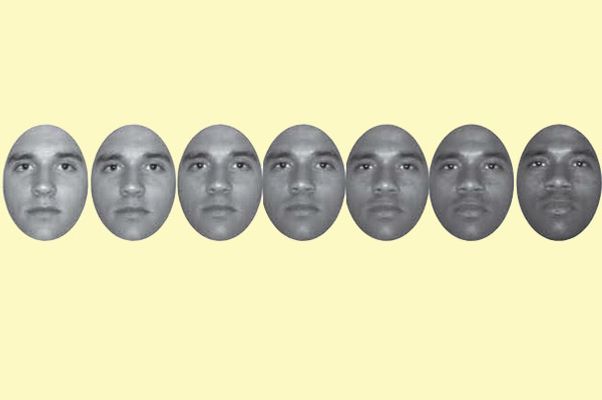Both common sense and a bunch of social-psychological literature suggest that when resources are scarce, folks tend to get more territorial and possessive, to stick with people whom they view as members of their in-groups more tightly than they usually would. An interesting new study in Proceedings of the National Academy of Sciences used face-morphing to show that white people, in one experiment at least, actually perceive black people differently when primed to think about situations in which resources are scarce.
The study mostly revolved around getting a group of white respondents to react to a range of faces generated by morphing the features of a stereotypically Caucasian face with a stereotypically African-American one. Here are some of them, from most white (left) to most black (right):

The researchers sum up their findings:
Together, our results provide strong converging evidence for the role of perceptual bias as a mechanism through which economic scarcity enhances discrimination and contributes to racial disparities. Studies 1 and 2 demonstrated that perceptions of scarcity, whether based on one’s economic beliefs or manipulated nonconsciously, increased subjects’ tendency to view mixed-race faces as “Blacker.” Studies 3 and 4 revealed that when resources were framed as scarce (versus neutral), decision makers’ mental image of African American faces became “Blacker,” and this perceptual shift was sufficient to cause a disparity in the allocation of resources. These findings demonstrate that socioeconomic context can shape perceptions of minority racial group members, and this process may contribute to the widening of racial disparities during economic stress.
The second study is probably the most interesting. In it, the researchers quickly flashed positive, neutral, or scarcity-related words, then flashed a face that was 100 percent black or white, or somewhere along the spectrum at 25 percent intervals. (The word-flashing thing is an established way of detecting bias when people might be reluctant to admit it, and forms the backbone of respected so-called implicit association tests.) Respondents were asked to determine the race of the face.
Those who had been primed with the scarcity words were more likely to see middle-of-the-road faces as black — on average, faces were identified as black if they were only 35 percent to the right on the spectrum, as compared to 40 percent for the neutral and negative groups (interestingly, there was no difference between these groups). This suggests that in-group/out-group perceptions — which we know are correlated with all sorts of not-good aspects of human nature — were heightened when the white subjects were made to think about scarcity, to the point where they were identifying faces that were more white than black (stereotypically speaking, at least) as black. Another one of the studies carried this a little further, showing that people divvied up hypothetical money-pies less equitably to a fictional black co-player in a game when scarcity-priming was used.
The standard caveats apply: This was a lab setting; in real life people make these sorts of decisions differently; and so on. But given previous research on race, scarcity, and bias, it’s a useful data point, and a useful reminder that scarcity has a lot of negative effects on human behavior — some of them a bit surprising.




